Abstract
Antibodies to molybdate-stabilized chicken oviduct progesterone receptor were raised in a Wistar rat and detected by interaction with homogeneous radioiodinated progesterone receptor. Spleen cells of this rat were then fused with mouse Sp2/0-Ag14 myeloma cells and the antibodies produced by the hybrid cells were detected by double immunoprecipitation using the 125I-labeled receptor. Cells of one of the positive cultures were then cloned by limiting dilution and one hybridoma cell line was studied. The monoclonal antibody produced was an IgG2b, and it reacted with the molybdate-stabilized "8-9S" form of the chicken oviduct progesterone receptor, labeled with either [3H]progesterone or [3H]ORG 2058 (a high-affinity synthetic progestin). Kd for the 8-9S progesterone receptor was approximately equal to 1 nM. Progesterone receptor-monoclonal antibody complexes were labeled with radioactive progesterone, suggesting that antibody does not prevent hormone binding. By using a [35S]methionine-labeled antibody, we were able to detect the progesterone receptor independently of its characteristic function of binding radioactive hormone. No crossreaction with human progesterone receptor was detected.
Full text
PDF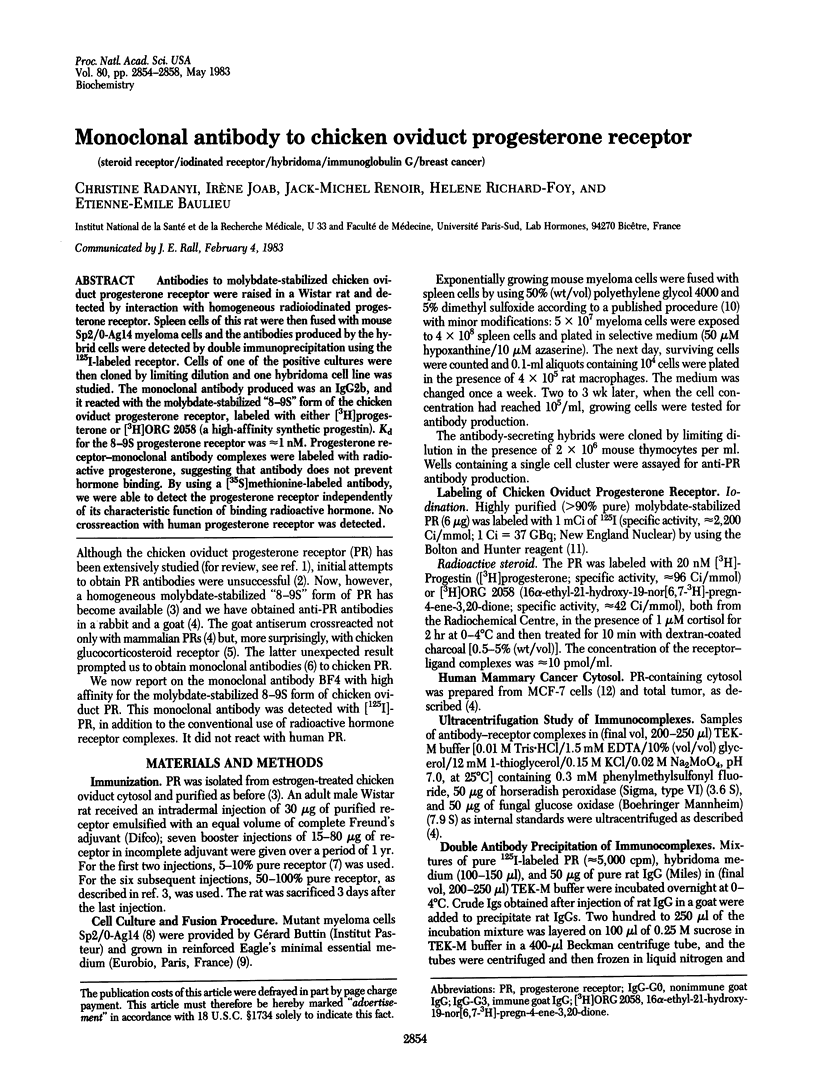
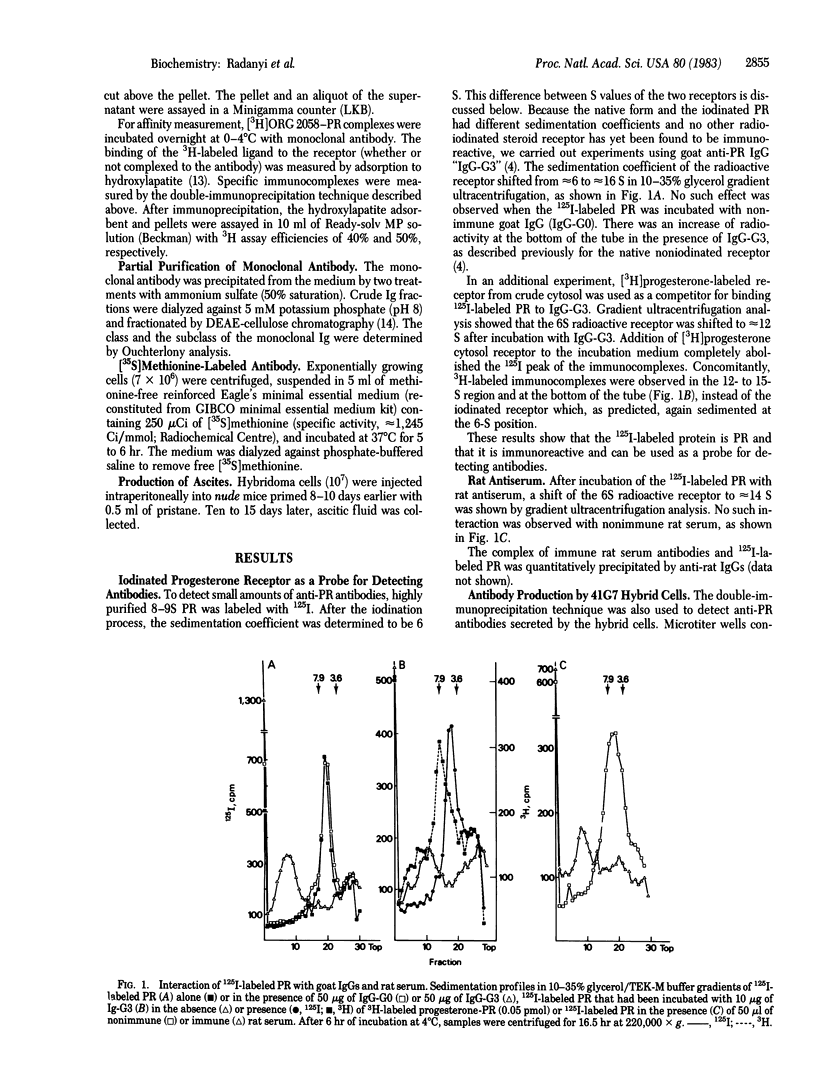
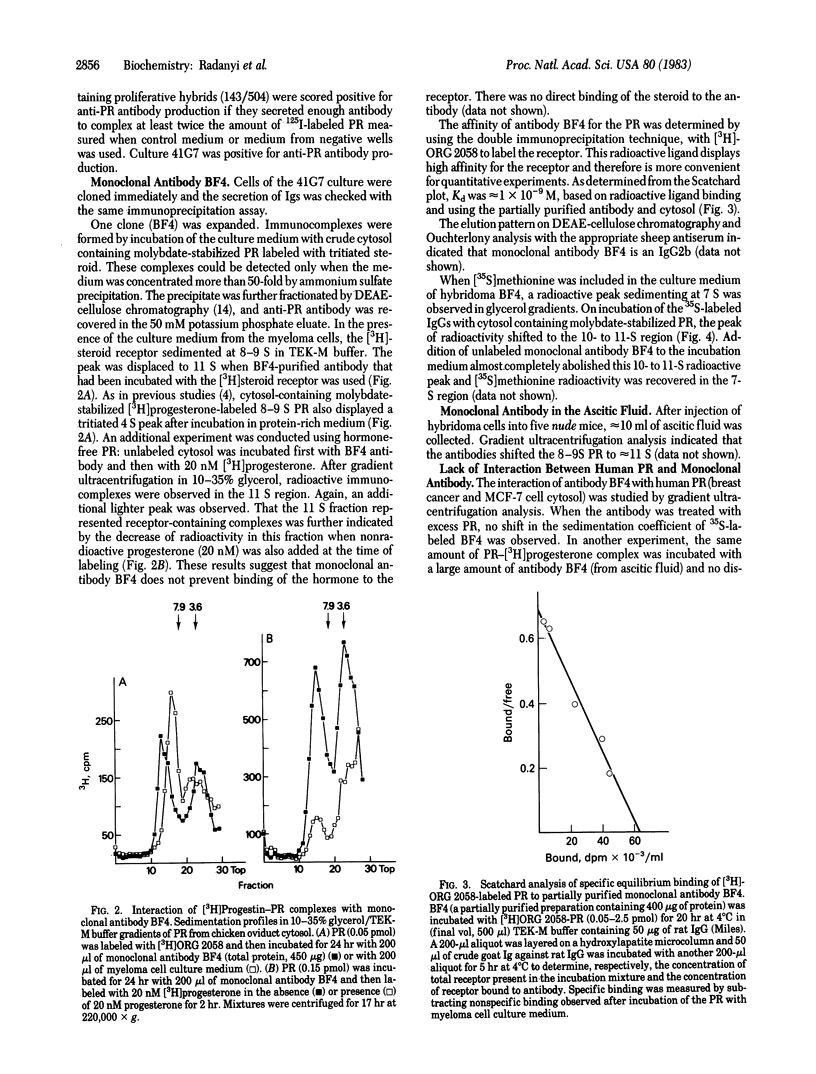
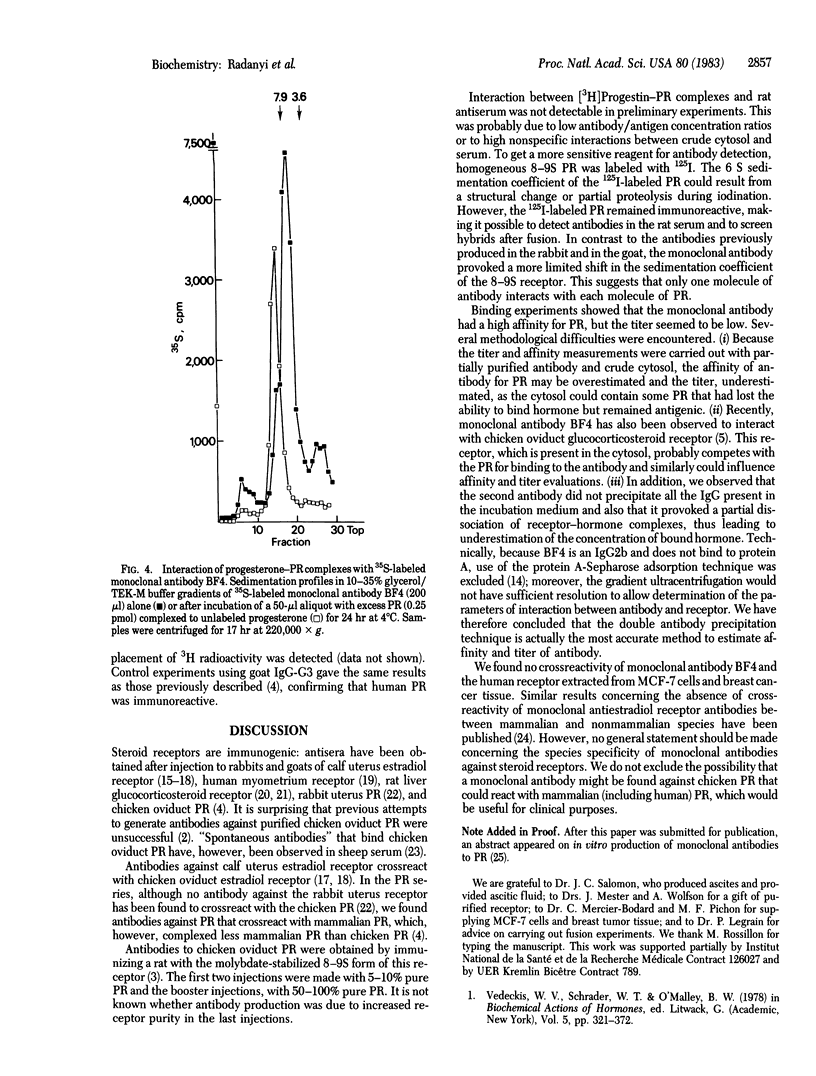
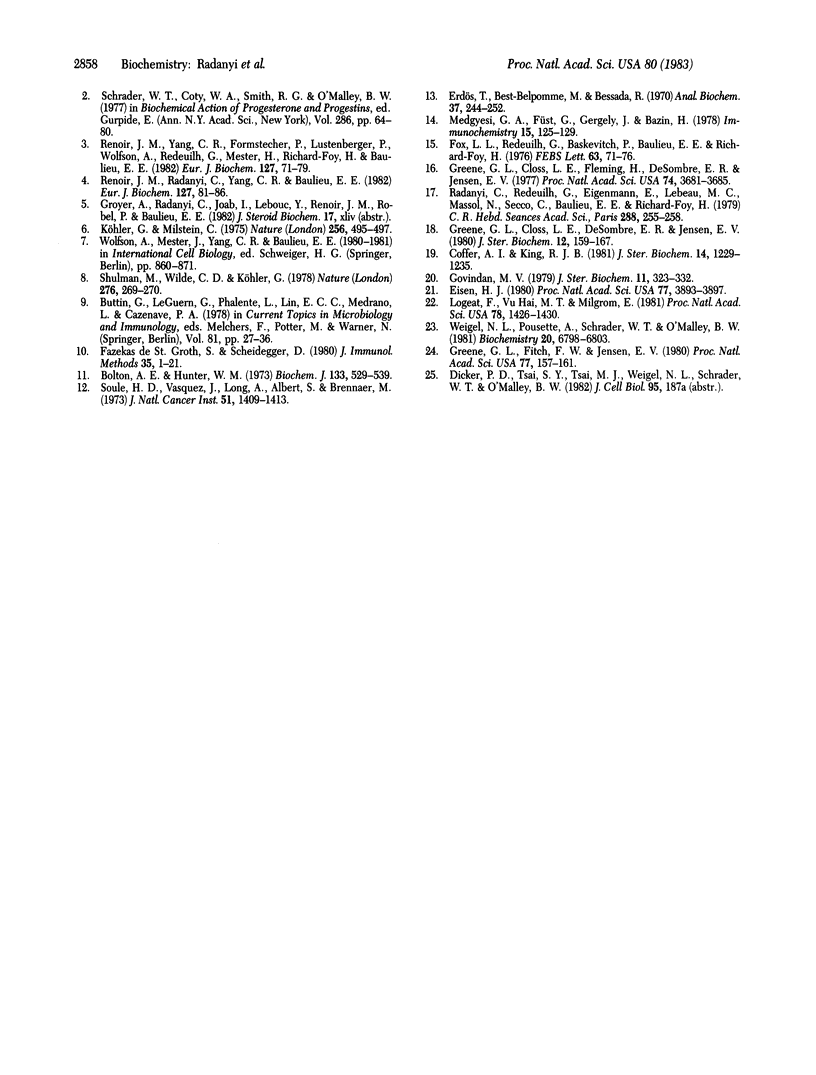
Selected References
These references are in PubMed. This may not be the complete list of references from this article.
- Bolton A. E., Hunter W. M. The labelling of proteins to high specific radioactivities by conjugation to a 125I-containing acylating agent. Biochem J. 1973 Jul;133(3):529–539. doi: 10.1042/bj1330529. [DOI] [PMC free article] [PubMed] [Google Scholar]
- Buttin G., LeGuern G., Phalente L., Lin E. C., Medrano L., Cazenave P. A. Production of hybrid lines secreting monoclonal anti-idiotypic antibodies by cell fusion on membrane filters. Curr Top Microbiol Immunol. 1978;81:27–36. doi: 10.1007/978-3-642-67448-8_4. [DOI] [PubMed] [Google Scholar]
- Coffer A. I., King R. J. Antibodies to estradiol receptor from human myometrium. J Steroid Biochem. 1981 Dec;14(12):1229–1235. doi: 10.1016/0022-4731(81)90325-3. [DOI] [PubMed] [Google Scholar]
- Eisen H. J. An antiserum to the rat liver glucocorticoid receptor. Proc Natl Acad Sci U S A. 1980 Jul;77(7):3893–3897. doi: 10.1073/pnas.77.7.3893. [DOI] [PMC free article] [PubMed] [Google Scholar]
- Erdos T., Best-Belpomme M., Bessada R. A rapid assay for binding estradiol to uterine receptor(s). Anal Biochem. 1970 Oct;37(2):244–252. doi: 10.1016/0003-2697(70)90044-8. [DOI] [PubMed] [Google Scholar]
- Fox L. L., Redeuilh G., Baskevitch P., Baulieu E. E., Richard-Foy H. Production and detection of antibodies against the estrogen receptor from calf uterine cytosol. FEBS Lett. 1976 Mar 15;63(1):71–76. doi: 10.1016/0014-5793(76)80197-4. [DOI] [PubMed] [Google Scholar]
- Govindan M. V. Purification of glucocorticoid receptors from rat liver cytosol. Preparation of antibodies against the major receptor proteins and application of immunological techniques to study activation and translocation. J Steroid Biochem. 1979 Jul;11(1A):323–332. doi: 10.1016/0022-4731(79)90315-7. [DOI] [PubMed] [Google Scholar]
- Greene G. L., Closs L. E., Fleming H., DeSombre E. R., Jensen E. V. Antibodies to estrogen receptor: immunochemical similarity of estrophilin from various mammalian species. Proc Natl Acad Sci U S A. 1977 Sep;74(9):3681–3685. doi: 10.1073/pnas.74.9.3681. [DOI] [PMC free article] [PubMed] [Google Scholar]
- Greene G. L., Fitch F. W., Jensen E. V. Monoclonal antibodies to estrophilin: probes for the study of estrogen receptors. Proc Natl Acad Sci U S A. 1980 Jan;77(1):157–161. doi: 10.1073/pnas.77.1.157. [DOI] [PMC free article] [PubMed] [Google Scholar]
- Köhler G., Milstein C. Continuous cultures of fused cells secreting antibody of predefined specificity. Nature. 1975 Aug 7;256(5517):495–497. doi: 10.1038/256495a0. [DOI] [PubMed] [Google Scholar]
- Logeat F., Hai M. T., Milgrom E. Antibodies to rabbit progesterone receptor: crossreaction with human receptor. Proc Natl Acad Sci U S A. 1981 Mar;78(3):1426–1430. doi: 10.1073/pnas.78.3.1426. [DOI] [PMC free article] [PubMed] [Google Scholar]
- Medgyesi G. A., Füst G., Gergely J., Bazin H. Classes and subclasses of rat immunoglobulins: interaction with the complement system and with staphylococcal protein A. Immunochemistry. 1978 Feb;15(2):125–129. doi: 10.1016/0161-5890(78)90052-4. [DOI] [PubMed] [Google Scholar]
- Radanyi C., Redeuilh G., Eigenmann E., Lebeau M. C., Massol N., Secco C., Baulieu E. E., Richard-Foy H. Production et détection d'anticorps antirécepteur de l'oesstradiol d'utérus de veau. Interaction avec le récepteur d'oviducte de poule. C R Seances Acad Sci D. 1979 Jan 15;288(2):255–258. [PubMed] [Google Scholar]
- Renoir J. M., Radanyi C., Yang C. R., Baulieu E. E. Antibodies against progesterone receptor from chick oviduct. Cross-reactivity with mammalian progesterone receptors. Eur J Biochem. 1982 Sep;127(1):81–86. doi: 10.1111/j.1432-1033.1982.tb06840.x. [DOI] [PubMed] [Google Scholar]
- Renoir J. M., Yang C. R., Formstecher P., Lustenberger P., Wolfson A., Redeuilh G., Mester J., Richard-Foy H., Baulieu E. E. Progesterone receptor from chick oviduct: purification of molybdate-stabilized form and preliminary characterization. Eur J Biochem. 1982 Sep;127(1):71–79. doi: 10.1111/j.1432-1033.1982.tb06839.x. [DOI] [PubMed] [Google Scholar]
- Schrader W. T., Coty W. A., Smith R. G., Malley B. W. Purification and properties of progesterone receptors from chick oviduct. Ann N Y Acad Sci. 1977 Mar 11;286:64–80. doi: 10.1111/j.1749-6632.1977.tb29405.x. [DOI] [PubMed] [Google Scholar]
- Shulman M., Wilde C. D., Köhler G. A better cell line for making hybridomas secreting specific antibodies. Nature. 1978 Nov 16;276(5685):269–270. doi: 10.1038/276269a0. [DOI] [PubMed] [Google Scholar]
- Soule H. D., Vazguez J., Long A., Albert S., Brennan M. A human cell line from a pleural effusion derived from a breast carcinoma. J Natl Cancer Inst. 1973 Nov;51(5):1409–1416. doi: 10.1093/jnci/51.5.1409. [DOI] [PubMed] [Google Scholar]
- Weigel N. L., Pousette A., Schrader W. T., O'Malley B. W. Analysis of chicken progesterone receptor structure using a spontaneous sheep antibody. Biochemistry. 1981 Nov 24;20(24):6798–6803. doi: 10.1021/bi00527a009. [DOI] [PubMed] [Google Scholar]


